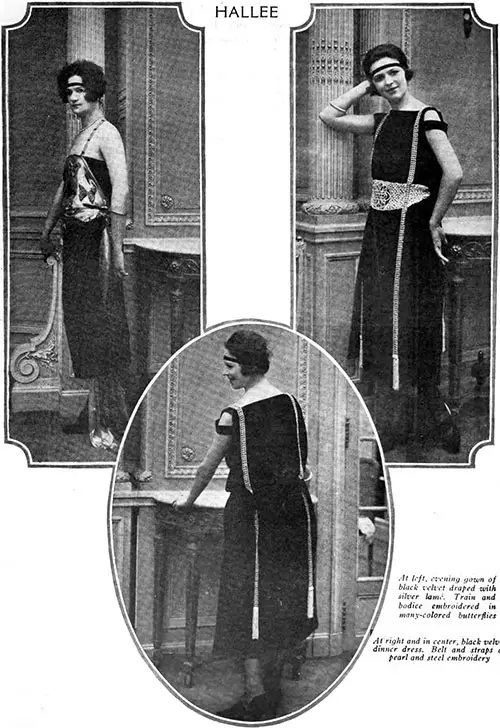Jeanne Hallée - Parisian Fashion Designer - 1920

At left, evening gown in black velvet draped with silver lame. Train and bodice embroidered in many-colored butterflies.
At right and center, black velvet dinner dress. Belt and straps of pearl and steel embroidery.
Coat-dresses will be prominent in the winter wardrobe. Artful draping of contrasting materials in evening gowns.
The old firm of Jeanne Hallée now belongs to M. Kamp and is directed by his wife, Madame Suzanne, who has made a great success of the much-restored establishment.
Madame Suzanne personally creates and designs all the models herself; a long connection with Worth and the famous Francis, combined with great talent, enable her to rank with the very first houses.
Velours de laine and duvetyn in blues and browns make up the bulk of the young, alert looking tailored suits at Jeanne Hallée. High collars, wide sleeves, trim medium jackets are characteristic.
A gorgeous model of dark blue, reminiscent of the eighteenth-century uniforms, is braided across the front in black with a suspicion of gold; a blue coat is worn with a skirt crossed and lined in raised red stripes.
A long snuff duvetyn is trimmed by beautiful ribbons pleated and used as braid. Coats are by no means shapeless here: the extra fullness is gathered towards the waist in front in flat pleats or shirring.
A black velvet afternoon wrap strikes a new note with its large sleeves and side gores of satin. Although we have both coats and capes amply represented a hybrid occurs in an old-blue coat which sports two short capes, edged with ragondin, that very superior beaver.
Silk fringe simulating fur helps to build up a very striking ensemble; it forms the collar of a very short tete de negre cape which accompanies a beige charmeuse dress cut into detached panels all around, each one edged by eighteen inches of the fringe.
Coat-dresses, which I think will be as much a part of our winter wardrobe as gloves or an umbrella, are well represented. Apart from the usual straight lines and high collars, they open in front almost to the waist in a long, narrow slit, much embroidered on each side.
A model that I liked very much gives an ever favored Parisian combination of color: the dress is of blue serge, the girdle of red leather thongs woven together; the sides of the dress are simply worked in checkered red leather, the collar lined in red.
The sleeves of all the dresses are most interesting; apart from bell-shapes, wide cuffs, etc., they can be pointed, or the stuff slashed from elbow to wrist and there gathered into a cuff.
Charmeuse, velvet, and crepe in very soft colors compose the majority of the more “dressy" frocks; I must not forget to include brocade and cloth of silver; “crepe crocodile,” a brand-new stuff, consistent, soft and glossy, slightly crinkled so as to suggest remotely alligator, is exquisite, in white or in black spotted with large black velvet pastilles.
A charming afternoon costume is a dress of black taffeta, the bodice crossed, the skirt stitched to the top in points, repeated around the hem by deep triangular inserts of black velvet.
A shortish black velvet cape goes with it. A smart little black satin “chemise" is embroidered down the front in white beads, a white ostrich flue caught in with each bead.
These dresses give a slim, straight line barely broken by a tunic, or a portion of one, lined in a contrasting color like this creation of black crepe crocodile, the square apron at the back lined in soft green and tied with a green sash.
Negre velvet is at its best with a low girdle of turquoises in front; the back of the bodice is loose and loops over the belt; steel bead straps hang from the shoulders to the hem at the back. A mole velvet dinner dress with a pointed décolleté has sleeves that may be mysteriously detached.
Now we come to gowns that have no sleeves at all; the collection of evening dresses is outstanding. A very novel idea is that of a black velvet, which forms the back of the frock and bi-forks on the ground into two square trains; the front is a panel of white satin striped horizontally in gold.
This idea is repeated several times, black velvet draped over white satin: silver lamé and velvet; the first much embroidered in many colored butterflies.
All this necessitates much draping—materials in sharp contrast demand careful handling, which they certainly get here. Red brocade is draped with a master hand by Madame Suzanne; I have a secret preference for a square necked maize satin; vast points cover the sides and meet in front under a jet ornament: the dress is embroidered in big jet flowers.
A delightful jeune fille gives a different note: a lace fichu over palest pink chiffon is completed by lace points on the skirt and a girdle of flowers.
Among the evening wraps, I noticed a coat embroidered in blue and yellow Chinese lettering; it has a collar and cuffs of sable ending in dangling tails.
"Jeanne Hallée" in the Garment Manufacturers’ Index, New York: The Allen-Nugent Co. Publishers, Vol. II, No. 3, October 1920: 34-35.
